Joel "J.
R." Miller
Chief Engineer / Jock
1972-1974
(posted 23 SEP
04)

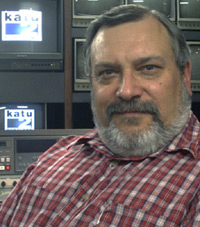


Bookmarks
1- Before KQ4
2- Rockin' in Quad?
3- Downhill slide
4- End game 5- KQ4 cars
6- KOIN Towers Collapse
On
September 15, 1972, as Chief Engineer of KQIV, I had the distinct
privilege of pressing the buttons that put our station on the air.
But, exactly how was it I was fortunate enough to be there for that
big event?
Before KQ4
Radio has
always fascinated me. I must have inherited the "gene" from my
father, who was a radio operator in Europe with the Headquarters of
the 274th Regiment, 70th Infantry Division, during World War II. I
still have fond memories of shortwave listening with my dad at an
early age in front of a big Zenith console. The warm glow of its vacuum tubes, the crackle of the
static, and the wavy sounding voices and music from all around the
world are unforgettable.
Shortwave
listening led to AM-band DX’ing. And then, following a brief foray
into the nutty world of the Citizens Band, I got my Novice Amateur
Radio license in 1968 as a junior at Tigard (Oregon)
High School. I liked Ham Radio so much, in just a few months I
qualified for an Advanced Class license. Soon afterward, I earned my
FCC First Class Radio Telephone Operator License.
Owing to my
interest in the technical aspects of radio, I set as an educational
goal a degree in Electronics Engineering. However, after a short
stint at Oregon State University, and realizing that slide rules and
calculus classes were not really my cup of tea, I enrolled in Keith
Allen’s broadcasting program at Portland Community College (PCC)
early in 1971. “Maybe I can be a DJ or a news guy,” I thought. The
new PCC campus at Mount Sylvania in southwest Portland had recently
opened, and because some of the buildings were still under
construction, we held our classes in a trailer. While at PCC, I was
Chief Engineer, a DJ and news reader for our campus station, KPCC
(650 AM).
I got my first paying
job in radio in the spring of 1971. On the recommendation of Keith
Allen, KPOK (1330 AM) program director Vern Mueller hired me to work
a few hours five nights a week screening calls on the "Nite Line"
talk show with Dick Klinger and later with former KATU Channel 2
newsman Bill Bartholomew. KPOK news director Neal Penland was even
considering a fill-in news reader job for me. Yes, radio is what I
wanted to do in life!
Rockin’ in
Quad?
In the fall
of 1971, I was honored to be included in a small group of Keith
Allen's students who were recruited by entrepreneur Walter J.M.
Kraus to help build a new FM station in Lake Oswego, Oregon. He was
looking for affordable employees in the form of eager, young
students.
 Mr.
Kraus had made his name by filling in part of the wetlands near the
Pony Slough in North Bend, Oregon, and developing the famous Pony
Village shopping center on the reclaimed land. He also founded
Oregon Coast Broadcasters in 1960, and put KRAF (1470 AM) on the air
from Reedsport, Oregon, on June 2, 1961 (click
here for larger view of letterhead). He sold the station to his
General Manager, Gless Connoy, in 1966. Mr.
Kraus had made his name by filling in part of the wetlands near the
Pony Slough in North Bend, Oregon, and developing the famous Pony
Village shopping center on the reclaimed land. He also founded
Oregon Coast Broadcasters in 1960, and put KRAF (1470 AM) on the air
from Reedsport, Oregon, on June 2, 1961 (click
here for larger view of letterhead). He sold the station to his
General Manager, Gless Connoy, in 1966.
In 1969,
after taking up residence in Lake Oswego, Mr. Kraus decided that his
well-heeled neighbors (and his wife) would enjoy a classical music,
opera and news station. “Music for the Oswego set," as Mr. Kraus
liked to say.
Eventually,
however, Mr. Kraus was talked out of the classical format and was
convinced to hit the air with a hybrid rock/folk/blues/jazz station.
In the fall
of 1971, Willamette Broadcasting Company owner Walter Kraus and
other staff members met with James Gabbert of KIOI (K-101) in San
Francisco and returned to Lake Oswego very excited. K-101 had
successfully transmitted true four-channel audio for the first time
on a single FM station using Quadraplex, a process invented by Lou
Dorren. The FCC was concerned, however, with certain technical
issues that had to be resolved before it would give Quadraplex its
blessing.
KQIV had hoped to be the first station in the Portland market to
utilize Quadraplex. Despite ongoing delays in FCC approval, outdoor
billboards announcing the station's arrival blanketed the Portland
area and proudly proclaimed "Credibility is back. KQ4 Quadraphonic
FM 107."
About a month before KQIV's on-air debut, the FCC released a
Public Notice that took the wind out of our sails, if only
temporarily.
During the
spring and summer of 1972 construction of the
studio and transmitter facilities designed by consulting engineer
Bob McClanathan continued.
The Lake
Oswego Elks lodge (now a church) on SW Stafford Road was about two
years old when our headquarters were constructed there (see
The Studios page). Walter Kraus
was a longtime member of the Elks, and he convinced them to let us
frame-in the building’s unused mezzanine. Mr. Kraus had numerous
Elks brothers in the construction trades and got a good deal by
having some of them do the work.
The
transmitter was located high atop Outlook, between Oregon City and
Carver, on a postage stamp-sized piece of property purchased from
Pacific Northwest Bell, next door to their microwave repeater (see
Xmitter & Tower page). Its
location met FCC criteria for station separation and for adequately
serving the city of license, Lake Oswego.
The concrete
block transmitter house was constructed by contractor C.G. Ferry.
After some stubborn rock had been dynamited out, the concrete piers
for the tower base and guy anchors were poured. Larry Sibley and V.
G. Duvall, Jr. of Utility Tower Company drove their boom truck and
flatbed trailer out from Oklahoma City with our 200-foot Type 380
tower. They erected the tower and put up our Jampro JSCP 8-bay
Penetrator side-mounted antenna along with the transmission line.
Bob McClanathan and I installed the American Electronic Laboratories
(AEL) FM-25KD transmitter and associated equipment. During our time
working at the transmitter site, Bob and I became regulars at
Mumpy’s Tavern in Carver. Their great hamburgers sure kept our
strength up.
Back at the
Elks lodge, the on-air and production booths were practically
identical (see The Studios page).
Most everything performed pretty well, but the two Langevin consoles
became troublesome. Designed more for use in recording studios, when
exposed to our heavy-duty radio environment their slider pots often
failed and they suffered from chronic module-to-chassis "connectoritis."
The reel-to-reel recorders were originally from Otari but after a
couple of years of very hard use they were replaced with Scully
units. Russco made the turntables, the cartridge players were
International Tapetronics Corporation (ITC) 3D triple-deckers, and
the microphones were Electro-Voice RE15’s.
And, while
our listeners were at the mercy of whatever quad format our albums
were encoded in at that moment, the on-air personalities enjoyed
quad sound in the booths with some pretty nice monitor systems. Each
consisted of a Marantz receiver feeding a Sansui QS-1 quad
synthesizer which fed two Marantz high-powered stereo amps powering
four Advent speakers.
The
Downhill Slide
Soon after
KQIV went on the air on September 15, 1972, enjoying a very
promising beginning, staff turnover started rearing its ugly head.
So many individuals came and went, sometimes it was hard to keep
track.
Mother Nature
became a factor, too.
On the
evening of Thursday, January 11, 1973, the Portland area was hit by
an ice storm, resulting in treacherous driving conditions, numerous
traffic accidents, and hospitals in the area reporting
standing-room-only situations. A glaze of up to 3/4-inches covered
most everything as the night progressed. I received a call from the
studios informing me that our transmitter was off the air. That was
bad news. Considering the grim scene out my window, did I really
want to try driving the ten miles from Lake Oswego to Outlook to see
what was going on?
Well, duty called and out I went to begin my
journey. Everything was going pretty smoothly, and by the time I
started up out of Park Place on Forsythe Road I could hear a weak
signal from the exciter. That was encouraging because I knew the
transmitter building still had power. (There was no back-up
generator.) After a great deal of slipping and sliding, I finally
reached Outlook Road and tried to drive up to the transmitter but my
car couldn't get any traction. So, I just parked where I ended up,
stepped out of the car and instantly slipped and fell on my butt.
"Boy, this is a lot of fun," I thought! I took off my shoes and
walked the couple of blocks up to our building in my stocking feet.
A surreal sight awaited me. Huge icicles hung from the guy cables
and equally angry looking spires jutted up from the ground. It was
cold, dark and eerie.
Once inside
the transmitter building, everything appeared all right, except that
the final amplifier had kicked-off. I twisted the power pot all the
way down and fired up the final. As I slowly increased the output
power, at about 15 kilowatts all heck broke loose, with severe
arcing and a blast that sounded like a shotgun going off in an
outhouse. I peeled myself off the wall and tried it again. There was
another deafening boom. Then I happened to notice that the recently
refilled dry nitrogen tank that pressurized the transmission line
was empty! Obviously, the antenna had a hole in it. "Just great!"
So, I gently brought the power up to about 5kw. It held OK, so at
least we had some signal on the air. I then “enjoyed” my very
slippery trip back home.
KQIV
continued to transmit at reduced power for a few days and once the
weather improved, a tower man went up and discovered that the deicer
pigtails had arced and burned holes in a few bays of the antenna.
Patches were installed over the holes and we were then able to
re-pressurize the line and get back up to full power. The
transmitter had suffered a bit, too. Warren Burtis, an AEL field
engineer, came out
from Pennsylvania and spent a couple of days cleaning up arc damage,
replacing tubes, and testing.
Although the antenna was repaired
following the big ice storm, if KQ4 was going to successfully
compete in the Portland market and have any chance of surviving,
something had to be done to improve reception in the greater
Portland area. Moving the transmitter to Mt. Scott in southeast
Portland was often mentioned as a good solution, but a relocation
was infeasible due to the station's rapidly tightening financial
condition.
During the temporary leave of
engineer Bob McClanathan to pursue other projects, Norm Herman came
aboard as a consultant in the summer of 1973 and performed an
antenna pattern study. Herman's findings led him to convince
management that the best fix would be to trade in the old antenna
for a new one. The replacement would be specified with beam tilt and
null fill options, hopefully which would improve reception. A new
radiator would also rid the facility of the troublesome electrical
and mechanical damage the old one had sustained. The replacement
Jampro JSCP-8 was ordered in August, and shipped in late-September,
1973.
KQIV
celebrated its first anniversary on September 15, 1973. The talent
lineup at the time included: Steve O'Shea, 6-10am; Mike Sakellarides,
10am-2pm; Norman Flint, 2-6pm; Jeff Clarke, 6-10pm; Larry Scott,
10pm-2am; Joe Collins, 2-6am; Program Director Jim LaFawn, Weekends,
and Joel "J.R." Miller, Weekends (spinning the tunes and doing
wee-hours maintenance).
Meanwhile,
the big day had arrived. The old antenna would be removed and the
new one installed, hopefully all in one very long day’s work.
The entire
staff arrived at the transmitter site very early on that cool,
overcast October day. Everyone pitched in to make the antenna
change-out happen on schedule. Upon resuming transmission, reports
are that reception in some areas had marginally improved.
Unfortunately, however, the new antenna also suffered some damage
with the arrival of the new winter.
The End
Game
Yes, there
were tough times at KQIV, with staff turnover, tight finances and
equipment problems. But some very good things happened, too. In my
case, I got to know a wonderful lady named Marty, who lived next
door to Faith, a former KQ4 jock. Marty often visited with Faith at
the station and, before long, I got to know Marty pretty well. Soon,
we were dating. Then, in November of 1973, Marty and I got married,
and we still are.
In February
of 1974, Bob McClanathan, our consulting engineer, took some time
off and turned over the watch to Don Wilkinson, Project Engineer at
Portland’s KATU television. Don and I were working late one night
performing some equipment tests and he asked me if I had ever
considered getting into television. He knew the financial situation
at KQ4 was terrible and he wanted to help me out. Don told me there
was a videotape editor job open at KATU and he wondered if I would
be interested in it. As much as I hated to leave, I just knew I
couldn’t pass up this great opportunity. Happily, I’ve enjoyed my
position at KATU now for over thirty years.
|
Additional
thought: (posted 27 SEP 04)
The KQIV cars!
In 1971, when the format was still being planned as
classical/opera/poetry, image was everything. KQIV would
appeal to the well-to-do, upscale listener. And, Walter Kraus
had the requisite rides for that image.
Several months before the station went on the air, however, it
was decided that KQIV was instead going to be a progressive
rocker. Walter determined that what he really needed now was a
daily driver that would reflect the station's new persona as
"radio for the common people."
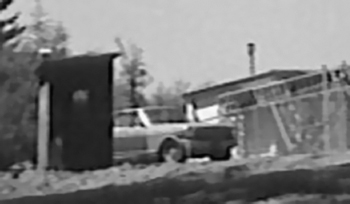 Unbelievably, he found just what he was looking for in my
metallic green 1963 Chevy II 100-Series 2-door sedan (pictured
at left). I
inherited the Chevy II from my dear aunt who lived only a
block from the beach in Newport, Oregon. The salty ocean air
certainly had taken somewhat of a toll on the car, but it
still ran fairly well. So, Walter told me he'd buy me a new
company car if I would give him the Chevy II. Well, that
sounded like a pretty fair deal to me! Unbelievably, he found just what he was looking for in my
metallic green 1963 Chevy II 100-Series 2-door sedan (pictured
at left). I
inherited the Chevy II from my dear aunt who lived only a
block from the beach in Newport, Oregon. The salty ocean air
certainly had taken somewhat of a toll on the car, but it
still ran fairly well. So, Walter told me he'd buy me a new
company car if I would give him the Chevy II. Well, that
sounded like a pretty fair deal to me!
Soon, the old rust-bucket would spend some time out at
International Collision Repair on Southeast Stark Street in
Portland for some extensive body repairs and a fresh paint job
in white. Hey, that little car looked great when they got done
with it! A local sign company applied big KQ4 logos on the
doors. Folks knew to look out as Walter, fat cigar in hand,
buzzed around the area in his little KQ4-Mobile. The custom
license plates on that car read "KQIV 2."
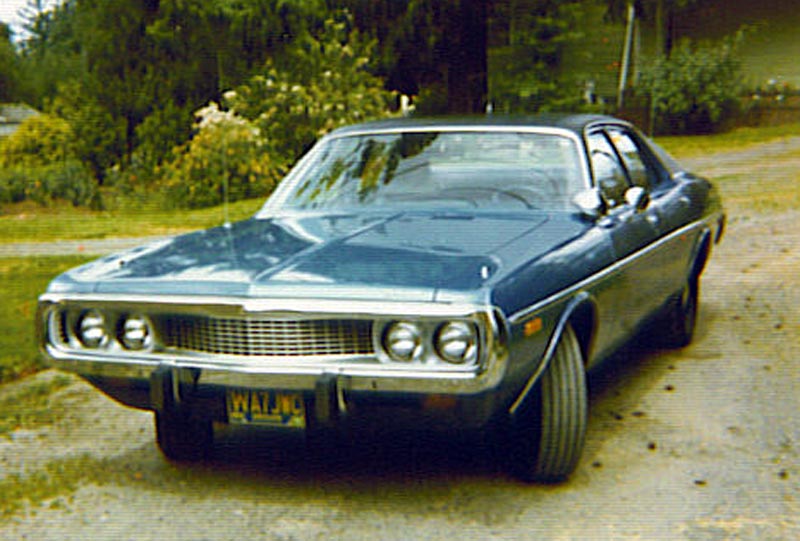 Now
that Walter had his car, it was my turn to take him up on his
offer and pick out a new ride for myself. The car that wore
the original custom plates "KQIV" was my brand-new 1973 Dodge
Coronet 4-door sedan in metallic blue (pictured at left -
click for larger view). In
October of 1972, I stopped by Jack Livingston (now Ron Tonkin)
Dodge in Gladstone, selected exactly what I wanted and placed
the order. I was told that my car probably would arrive
sometime around Thanksgiving. For the next several weeks, I
was like a little kid waiting for Christmas. My first new car
was being built! On Thanksgiving morning, I headed out for my
daily transmitter inspection in the little pickup I had been
borrowing when I decided, just for kicks, to drive by
Livingston Dodge to see if, by chance, my car had arrived. The
dealership was closed for the holiday, so I looked all over
but didn't find anything. One last check around in the back
lot and, to my amazement, there it was! My new Dodge! I was so
excited! But, of course, I would have to be patient and wait
another day or so to drive it home. Soon, the Coronet bristled
with my Ham radio and scanner antennas, and even a spotlight.
It fit my somewhat conservative nature - a relatively
short-haired, clean-shaven techy type. Staffers and visitors
often rolled their eyes when they spotted the KQIV "police
cruiser" parked at the station! "What's with that car?" Our
Elks Lodge brothers liked it, though! Walter kept bugging me
about letting him have the "KQIV" license plates to put on his
Chevy II, so I soon gave them up and put plates with my
Amateur Radio call letters on my new car. Now
that Walter had his car, it was my turn to take him up on his
offer and pick out a new ride for myself. The car that wore
the original custom plates "KQIV" was my brand-new 1973 Dodge
Coronet 4-door sedan in metallic blue (pictured at left -
click for larger view). In
October of 1972, I stopped by Jack Livingston (now Ron Tonkin)
Dodge in Gladstone, selected exactly what I wanted and placed
the order. I was told that my car probably would arrive
sometime around Thanksgiving. For the next several weeks, I
was like a little kid waiting for Christmas. My first new car
was being built! On Thanksgiving morning, I headed out for my
daily transmitter inspection in the little pickup I had been
borrowing when I decided, just for kicks, to drive by
Livingston Dodge to see if, by chance, my car had arrived. The
dealership was closed for the holiday, so I looked all over
but didn't find anything. One last check around in the back
lot and, to my amazement, there it was! My new Dodge! I was so
excited! But, of course, I would have to be patient and wait
another day or so to drive it home. Soon, the Coronet bristled
with my Ham radio and scanner antennas, and even a spotlight.
It fit my somewhat conservative nature - a relatively
short-haired, clean-shaven techy type. Staffers and visitors
often rolled their eyes when they spotted the KQIV "police
cruiser" parked at the station! "What's with that car?" Our
Elks Lodge brothers liked it, though! Walter kept bugging me
about letting him have the "KQIV" license plates to put on his
Chevy II, so I soon gave them up and put plates with my
Amateur Radio call letters on my new car.
 By the way, General Manager Jack Malone drove a red 1970
Porsche 914 with custom plates "KQ4." By the way, General Manager Jack Malone drove a red 1970
Porsche 914 with custom plates "KQ4."
And, that's what I remember about the early cars of KQIV.
|
Additional
thought: (posted 30 DEC 04)
If you’re going to come down, please wait till I’m gone!
Thinking back to that big ice storm in January 1973, as I was
attempting to get the KQIV transmitter back on the air, I’m
reminded of the mental snapshots I kept seeing that night.
On Saturday, February 27, 1971, at 1:18am, Mount Hood Radio &
Television Broadcasting Corp. lost two of their giant
transmission towers in the west hills of Portland due to heavy
icing and wind gusts; the 1000’ main tower for KOIN-TV &
KOIN-FM (built in 1963), and the 700’ auxiliary (originally
the main tower, constructed in 1954).
A
few days later, I visited the KOIN transmitter site on SW
Barnes Road near Skyline Boulevard. As I looked around,
bewildered by the heaps of twisted steel lying in the snow, I
took some photographs and spoke with Lloyd Street, the
engineer on duty the night of the collapses. Fortunately, he
was uninjured as the huge falling towers damaged part of the
transmitter building.
My photographs appear below. For larger
views, select the yellow "click".
|
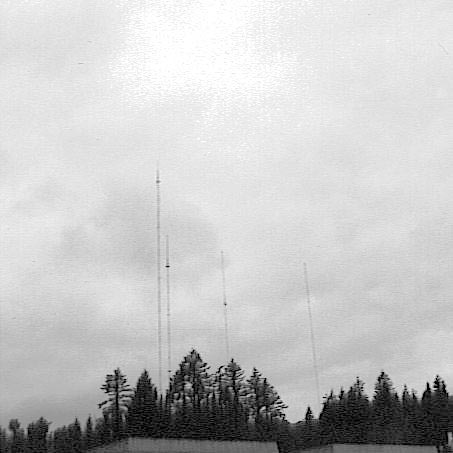
The Mount
Hood Radio & TV towers
in 1970 as seen from the Sunset Highway. Left to right:
the 1000' main for KOIN-TV & KOIN-FM, the 700'
auxiliary, and the two 545' KOIN-AM towers. click |

The KOIN-TV/KOIN-FM main and auxiliary
towers in 1970.
click
|
|
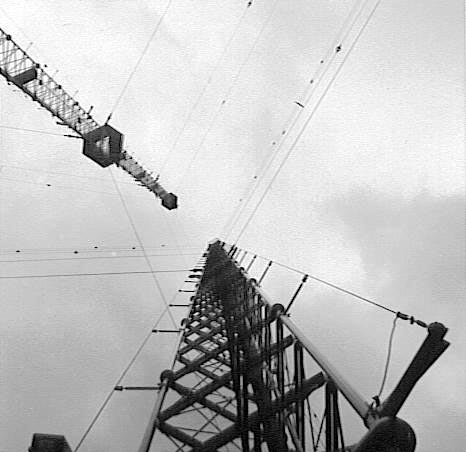
Looking straight up the 1000' KOIN-TV/KOIN-FM
main tower. click
|
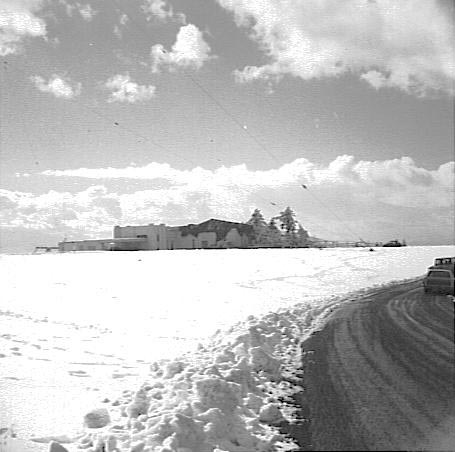
Tarps cover the damaged portion of the
KOIN transmitter building while the destroyed towers lie
on the ground to the right.
click |
|
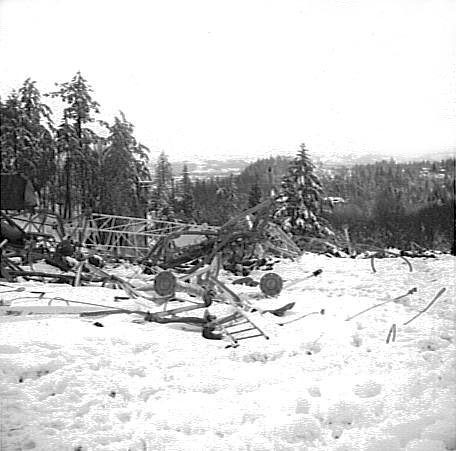
Portions of the downed KOIN towers litter
the hillside in twisted heaps.
click
|
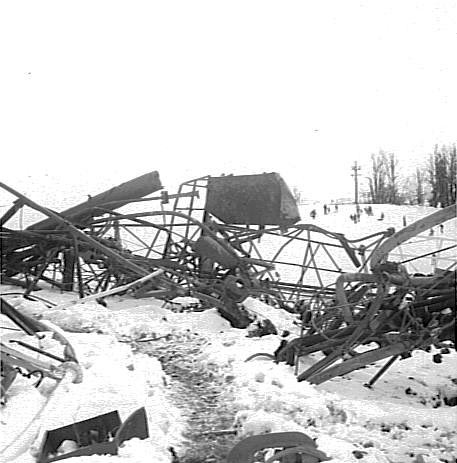
In the background, children play in the
snow as a once proud KOIN sentinel lies contorted and
silent, defeated by Mother Nature.
click |
|
Additional
photographs (below) of the aftermath of the
1971 KOIN transmission towers collapse from the files of
the late
William "Bill" Vandermay - W7ZZ, founding Chief
Engineer of KATU Channel 2. |
|
An auxiliary
tower, which had been taken down in the 1960's, was
reassembled on its original base. Just nine days
after the collapse of its two main
transmission towers in 1971, KOIN-TV returned to the air
with this temporary setup. |
|
Where's Joel now?
|